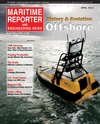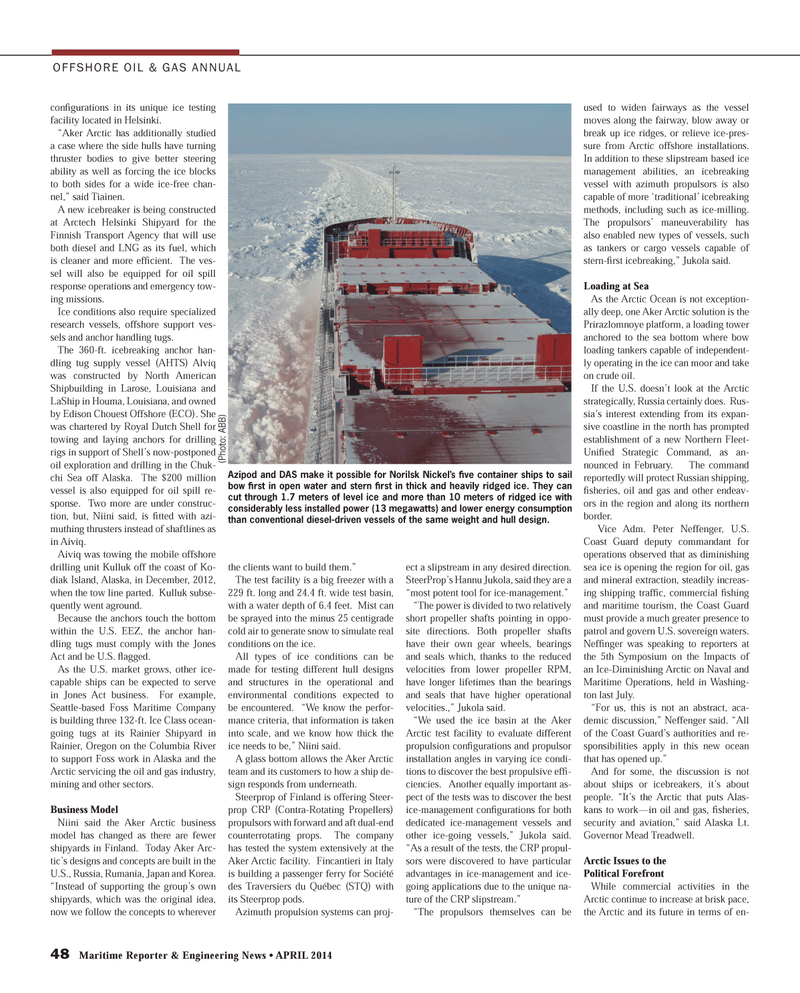
Page 48: of Maritime Reporter Magazine (April 2014)
Offshore Edition
Read this page in Pdf, Flash or Html5 edition of April 2014 Maritime Reporter Magazine
48 Maritime Reporter & Engineering News ? APRIL 2014 conÞ gurations in its unique ice testing facility located in Helsinki. ?Aker Arctic has additionally studied a case where the side hulls have turning thruster bodies to give better steering ability as well as forcing the ice blocks to both sides for a wide ice-free chan-nel,? said Tiainen. A new icebreaker is being constructed at Arctech Helsinki Shipyard for the Finnish Transport Agency that will use both diesel and LNG as its fuel, which is cleaner and more efÞ cient. The ves- sel will also be equipped for oil spill response operations and emergency tow- ing missions.Ice conditions also require specialized research vessels, offshore support ves- sels and anchor handling tugs.The 360-ft. icebreaking anchor han-dling tug supply vessel (AHTS) Alviq was constructed by North American Shipbuilding in Larose, Louisiana and LaShip in Houma, Louisiana, and owned by Edison Chouest Offshore (ECO). She was chartered by Royal Dutch Shell for towing and laying anchors for drilling rigs in support of Shell?s now-postponed oil exploration and drilling in the Chuk-chi Sea off Alaska. The $200 million vessel is also equipped for oil spill re-sponse. Two more are under construc- tion, but, Niini said, is Þ tted with azi- muthing thrusters instead of shaftlines as in Aiviq.Aiviq was towing the mobile offshore drilling unit Kulluk off the coast of Ko- diak Island, Alaska, in December, 2012, when the tow line parted. Kulluk subse-quently went aground.Because the anchors touch the bottom within the U.S. EEZ, the anchor han-dling tugs must comply with the Jones Act and be U.S. ß agged.As the U.S. market grows, other ice-capable ships can be expected to serve in Jones Act business. For example, Seattle-based Foss Maritime Company is building three 132-ft. Ice Class ocean-going tugs at its Rainier Shipyard in Rainier, Oregon on the Columbia River to support Foss work in Alaska and the Arctic servicing the oil and gas industry, mining and other sectors.Business ModelNiini said the Aker Arctic business model has changed as there are fewer shipyards in Finland. Today Aker Arc- tic?s designs and concepts are built in the U.S., Russia, Rumania, Japan and Korea. ?Instead of supporting the group?s own shipyards, which was the original idea, now we follow the concepts to wherever the clients want to build them.?The test facility is a big freezer with a 229 ft. long and 24.4 ft. wide test basin, with a water depth of 6.4 feet. Mist can be sprayed into the minus 25 centigrade cold air to generate snow to simulate real conditions on the ice. All types of ice conditions can be made for testing different hull designs and structures in the operational and environmental conditions expected to be encountered. ?We know the perfor- mance criteria, that information is taken into scale, and we know how thick the ice needs to be,? Niini said. A glass bottom allows the Aker Arctic team and its customers to how a ship de-sign responds from underneath. Steerprop of Finland is offering Steer- prop CRP (Contra-Rotating Propellers) propulsors with forward and aft dual-end counterrotating props. The company has tested the system extensively at the Aker Arctic facility. Fincantieri in Italy is building a passenger ferry for Société des Traversiers du Québec (STQ) with its Steerprop pods.Azimuth propulsion systems can proj-ect a slipstream in any desired direction. SteerProp?s Hannu Jukola, said they are a ?most potent tool for ice-management.??The power is divided to two relatively short propeller shafts pointing in oppo-site directions. Both propeller shafts have their own gear wheels, bearings and seals which, thanks to the reduced velocities from lower propeller RPM, have longer lifetimes than the bearings and seals that have higher operational velocities.,? Jukola said.?We used the ice basin at the Aker Arctic test facility to evaluate different propulsion conÞ gurations and propulsor installation angles in varying ice condi-tions to discover the best propulsive efÞ -ciencies. Another equally important as- pect of the tests was to discover the best ice-management conÞ gurations for both dedicated ice-management vessels and other ice-going vessels,? Jukola said. ?As a result of the tests, the CRP propul- sors were discovered to have particular advantages in ice-management and ice-going applications due to the unique na-ture of the CRP slipstream.? ?The propulsors themselves can be used to widen fairways as the vessel moves along the fairway, blow away or break up ice ridges, or relieve ice-pres-sure from Arctic offshore installations. In addition to these slipstream based ice management abilities, an icebreaking vessel with azimuth propulsors is also capable of more ?traditional? icebreaking methods, including such as ice-milling. The propulsors? maneuverability has also enabled new types of vessels, such as tankers or cargo vessels capable of stern-Þ rst icebreaking,? Jukola said. Loading at SeaAs the Arctic Ocean is not exception- ally deep, one Aker Arctic solution is the Prirazlomnoye platform, a loading tower anchored to the sea bottom where bow loading tankers capable of independent-ly operating in the ice can moor and take on crude oil.If the U.S. doesn?t look at the Arctic strategically, Russia certainly does. Rus- sia?s interest extending from its expan- sive coastline in the north has prompted establishment of a new Northern Fleet-UniÞ ed Strategic Command, as an- nounced in February. The command reportedly will protect Russian shipping, Þ sheries, oil and gas and other endeav- ors in the region and along its northern border. Vice Adm. Peter Neffenger, U.S. Coast Guard deputy commandant for operations observed that as diminishing sea ice is opening the region for oil, gas and mineral extraction, steadily increas-ing shipping trafÞ c, commercial Þ shing and maritime tourism, the Coast Guard must provide a much greater presence to patrol and govern U.S. sovereign waters. NefÞ nger was speaking to reporters at the 5th Symposium on the Impacts of an Ice-Diminishing Arctic on Naval and Maritime Operations, held in Washing- ton last July. ?For us, this is not an abstract, aca-demic discussion,? Neffenger said. ?All of the Coast Guard?s authorities and re- sponsibilities apply in this new ocean that has opened up.?And for some, the discussion is not about ships or icebreakers, it?s about people. ?It?s the Arctic that puts Alas- kans to work?in oil and gas, Þ sheries, security and aviation,? said Alaska Lt. Governor Mead Treadwell. Arctic Issues to the Political Forefront While commercial activities in the Arctic continue to increase at brisk pace, the Arctic and its future in terms of en- OFFSHORE OIL & GAS ANNUAL Azipod and DAS make it possible for Norilsk Nickel?s ve container ships to sail bow rst in open water and stern rst in thick and heavily ridged ice. They can cut through 1.7 meters of level ice and more than 10 meters of ridged ice with considerably less installed power (13 megawatts) and lower energy consumption than conventional diesel-driven vessels of the same weight and hull design. (Photo: ABB)MR #4 (42-49).indd 48MR #4 (42-49).indd 484/7/2014 4:04:36 PM4/7/2014 4:04:36 PM

 47
47

 49
49
